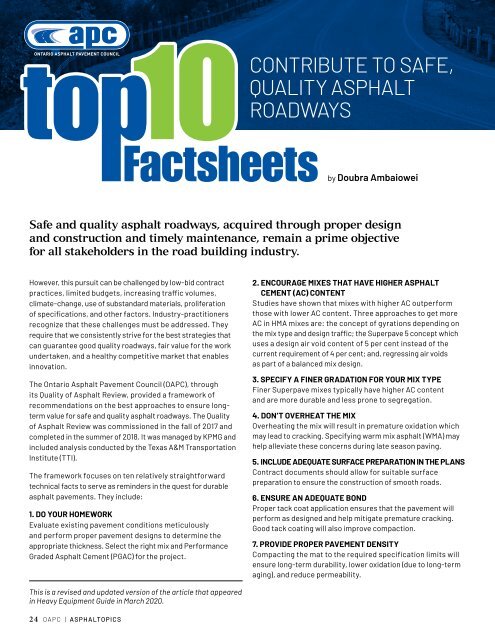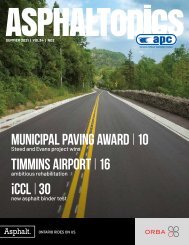ASPHALTopics | Fall 2020 | VOL 33 | NO 3
Create successful ePaper yourself
Turn your PDF publications into a flip-book with our unique Google optimized e-Paper software.
CONTRIBUTE TO SAFE,<br />
QUALITY ASPHALT<br />
ROADWAYS<br />
Factsheets<br />
by Doubra Ambaiowei<br />
Safe and quality asphalt roadways, acquired through proper design<br />
and construction and timely maintenance, remain a prime objective<br />
for all stakeholders in the road building industry.<br />
However, this pursuit can be challenged by low-bid contract<br />
practices, limited budgets, increasing traffic volumes,<br />
climate-change, use of substandard materials, proliferation<br />
of specifications, and other factors. Industry-practitioners<br />
recognize that these challenges must be addressed. They<br />
require that we consistently strive for the best strategies that<br />
can guarantee good quality roadways, fair value for the work<br />
undertaken, and a healthy competitive market that enables<br />
innovation.<br />
The Ontario Asphalt Pavement Council (OAPC), through<br />
its Quality of Asphalt Review, provided a framework of<br />
recommendations on the best approaches to ensure longterm<br />
value for safe and quality asphalt roadways. The Quality<br />
of Asphalt Review was commissioned in the fall of 2017 and<br />
completed in the summer of 2018. It was managed by KPMG and<br />
included analysis conducted by the Texas A&M Transportation<br />
Institute (TTI).<br />
The framework focuses on ten relatively straightforward<br />
technical facts to serve as reminders in the quest for durable<br />
asphalt pavements. They include:<br />
1. DO YOUR HOMEWORK<br />
Evaluate existing pavement conditions meticulously<br />
and perform proper pavement designs to determine the<br />
appropriate thickness. Select the right mix and Performance<br />
Graded Asphalt Cement (PGAC) for the project.<br />
2. ENCOURAGE MIXES THAT HAVE HIGHER ASPHALT<br />
CEMENT (AC) CONTENT<br />
Studies have shown that mixes with higher AC outperform<br />
those with lower AC content. Three approaches to get more<br />
AC in HMA mixes are: the concept of gyrations depending on<br />
the mix type and design traffic; the Superpave 5 concept which<br />
uses a design air void content of 5 per cent instead of the<br />
current requirement of 4 per cent; and, regressing air voids<br />
as part of a balanced mix design.<br />
3. SPECIFY A FINER GRADATION FOR YOUR MIX TYPE<br />
Finer Superpave mixes typically have higher AC content<br />
and are more durable and less prone to segregation.<br />
4. DON’T OVERHEAT THE MIX<br />
Overheating the mix will result in premature oxidation which<br />
may lead to cracking. Specifying warm mix asphalt (WMA) may<br />
help alleviate these concerns during late season paving.<br />
5. INCLUDE ADEQUATE SURFACE PREPARATION IN THE PLANS<br />
Contract documents should allow for suitable surface<br />
preparation to ensure the construction of smooth roads.<br />
6. ENSURE AN ADEQUATE BOND<br />
Proper tack coat application ensures that the pavement will<br />
perform as designed and help mitigate premature cracking.<br />
Good tack coating will also improve compaction.<br />
7. PROVIDE PROPER PAVEMENT DENSITY<br />
Compacting the mat to the required specification limits will<br />
ensure long-term durability, lower oxidation (due to long-term<br />
aging), and reduce permeability.<br />
This is a revised and updated version of the article that appeared<br />
in Heavy Equipment Guide in March <strong>2020</strong>.<br />
24 OAPC | ASPHALTOPICS

















